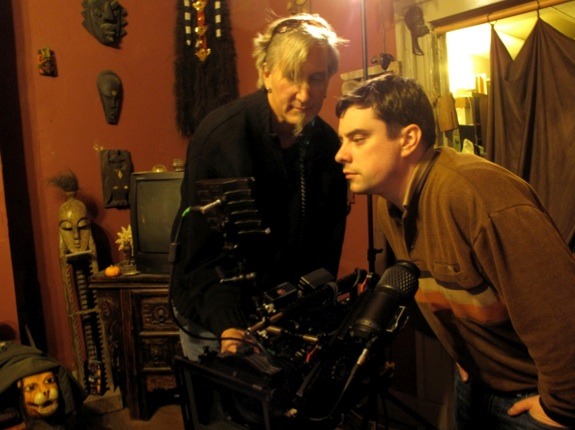
Filmmaking | Interviews | Local Industry | Massachusetts | New England | Reports
Make What You Are: A Talk with Theodore Collatos
Written by K. Correia | Posted by: JMG
While not restricting himself to a particular genre, Theodore Collatos is creating his own style of filmmaking and gaining the attention of critics and filmgoers alike. With successes like The Chosen One and Solitaire to his credit, Collatos shows no sign of slowing down. He, along with his wife and co-producer, Carolina Monnerat, currently have two films in the works, Tom Collins, about an alcoholic ex-con trying to rebuild his life and reconnect with his family and Move, about the struggles of a Chicago based contemporary African American dance company.
K. Correia: Recently, NewEnglandFilm.com has run articles weighing in on the pros and cons of film school and film schools in New England. How did you get your start as a filmmaker? Did you go to film school?
Theodore Collatos: I got started as a filmmaker at the School of the Art Institute of Chicago. It was there that I saw Persona by Ingmar Bergman for the first time. It blew my 18-year-old mind! I’d only been exposed to Hollywood films at that point. I was a photographer at the time and started fulfilling my Art History credits with Film History classes. I was afraid to dive into filmmaking at first. So, I took two years of history classes like French New Wave, Cinema of Ingmar Bergman, Czech New Wave, and History of Video along with photography, painting, drawing and film production before transferring to Columbia College, Chicago Film School.
I had an awesome time at film school… Columbia was great at that time. You really had enough freedom to experiment but there was a strong technical and narrative emphasis that anyone starting out needs. Columbia was also very supportive with my independent projects and I ended up getting many grants from Columbia College…
KC: Where do you get your ideas and motivation to make a certain film?
Collatos: My motivation for making certain films is directly influenced by what is happening in my life at the time. As an independent filmmaker, I don’t have the luxury of creating an idea in my head and having it funded and made.
My process is very organic and practical. If I can’t pull it off, I won’t even go past the writing stage. Hopefully, someday this will grow into another process where I give a script to a producer and they help… I am motivated though, to make films that move people in a private way like the way Persona did to me as a kid.
Film is a church to me. It’s where I’ve learned a lot about how to treat people and how to be a person. It relaxes me and is a meditative experience for me. I look for films that are true to our humanity. And sometimes, you just want a film to kick ass.
KC: Currently, you have two films in the works — what do you see as the main differences between the two in terms of narrative style?
Collatos: The two films I’m working on now are different because one is a narrative drama, Tom Collins, and the other is a documentary, Move. In a narrative you have to write the story, organize with people, locations, actors… budget is a big concern, then frame shots, work with people and get it done… The way I make documentaries is just by picking up the camera and shooting and finding the story in the edit… Ultimately, with a documentary you have to have a deep rapport and relationship with your subject for it to come off as authentic.
KC: Is there any difference in how you approached the production of each of these films?
Collatos: The production of these films is opposite and that’s why I enjoy doing both narrative dramas and documentary…
With Tom Collins we got very lucky and shot with the Red One because Solar System Studio believed in us and introduced us with an amazing Emmy-winning cinematographer, Thomas Lowe. He was a godsend. The cast doubled as crew and the process was incredibly hard. We all lived in a house together and shot as much as we could each day…
The editing process is very different. It took two months to edit Tom Collins and five years to edit Move. This is because the footage is laid out for you in a narrative and is expansive in a documentary and it takes awhile to find out what the documentary is about… I try to let things be and not force things to be a certain way. I find if you set the stage things will happen naturally. If they don’t, it’s an indication that there’s a problem. Things need to flow by themselves at some level or else things will be untrue and will fall flat on the screen.
KC: For you, what are each of these films truly about?
Collatos: With Tom Collins, I had been living in western Massachusetts for many years, where the story takes place, and I wanted to create a story using real people and real locations based partly on the lives of the people involved… Tom Collins is set in Pittsfield, MA, which was a thriving General Electric town and now is a post-industrial town trying to redefine itself amongst the devastation that GE has left… It’s about what’s happening on the ground in so many American cities now. The lack of future for so many of us and the cycle of the system… I wanted to tell that story in a personal way through the eyes of people who are directly affected by it. The film is about following your dream.
Move is about two major dance choreographers, Kevin Iega Jeff and Gary Abbott and their Deeply Rooted Dance Theater (DRDT). My wife and co-producer is a senior company member of DRDT and we thought it would be a great opportunity to tell their story… Move talks about the struggles to create art in a country that could care less about art and the subject’s personal journeys through a life in dance. The film talks about where we should be as a culture now in terms of race, gender and post-Obama politics, in the context of a pre-Obama election. An example of this is how the black community was upset at Jeff because he included white people in his African American contemporary company. I found this very interesting and the film is sprinkled with these kind of unexpected details. Ultimately, Move is an intimate portrait of the dancers, the choreographers and the strain of a touring dance company.
KC: Do you have any other projects on the horizon?
Collatos: As far as the future, we are developing a documentary that will be shot in Rio de Janeiro, Brazil and also a dramatic feature script that will hopefully have a producer and a real budget. But something else may distract me to the point of jumping off a cliff and shooting something else. It’s hard, and I’d like to grow to a point where I have an additional producer to help with the process so I could just focus on the filmmaking aspects only.










